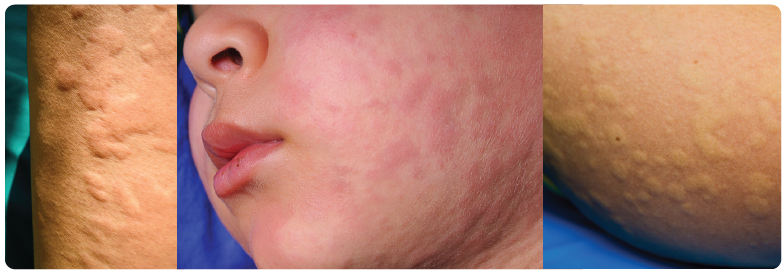

We commonly refer to it as rubella, but its scientific name is urticaria. Stinging Nettle is a plant that contains histamine and when the skin is irritated by nettles, histamine can trigger itching, redness, and rashes; which are the symptoms of hives. In addition to stinging nettles, there are other factors that can cause hives.

1. Acute urticaria: onset of less than six weeks
2. Chronic urticaria: onset for more than six weeks
1. Allergic reactions
2. Immune Response to Infection
3. Autoimmune Response

When acute urticaria occurs, the patient develops symptoms within one to two hours after being exposed to the allergen (such as drugs, food, or insects). For instance, some people are allergic to seafood such as shrimps and crabs. But whenever they eat such foods, it will gradually disappear within a day. Rubella will reappear when they come into contact with the same food again.
Sometimes, patients may not be completely aware that they have an allergic reaction to a certain food. Some people may be allergic to food with additives or seasonings such as ginger and garlic. Food allergies usually trigger acute urticaria.
Environmental allergens can also lead to acute urticaria. For example, people with animal allergies will develop urticaria after coming into contact with cats and dogs, while people with dust mite allergies or people with nasal allergies and asthma may experience urticaria after being exposed to dust or dusty objects as well as from unwashed sweaters.
About Allergy TestParasitic infections are the main cause of urticaria in some developing countries. However, more developed regions like Hong Kong may also be infected by parasites, such as from consuming sashimi or raising pets at home. School children are highly vulnerable to this type of infection as they have less personal hygiene and little awareness of parasites prevention and control measures.
The more common viruses are Norwalk virus and rotavirus that cause gastroenteritis, hence, patients with gastroenteritis are more likely to develop urticaria. In addition, some long-term viruses such as hepatitis carriers are more likely to develop urticaria as well, and will continue for a period of time until the hepatitis is cured.
Autoimmunity is defined as immunopathology initiated by a specific immune response to autologous components, producing antibodies and immune cells to attack body tissues, and finally causing autoimmune diseases. There are many types of autoimmune diseases, the general ones are rheumatoid arthritis and lupus erythematosus. Patients with these two systemic immune diseases are more prone to develop urticaria, but such patients onlu account for less than 2% of the overall chronic urticaria.
Some studies have found that about 60-70% of patients with chronic urticaria also develop allergic reactions to their serum, that is, antibodies against immunoglobulin E (IgE) receptors and these antibodies can lead to hypertrophy. The cells become active and will release histamine, causing the phenomenon of hives. This type of chronic urticaria can be diagnosed with autologous serum skin tests.